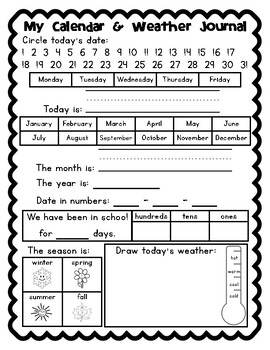Daily Calendar and Weather Journal Morning Meeting
Dana Cornwell
27 Followers
Grade Levels
PreK - 2nd, Homeschool
Subjects
Resource Type
Standards
CCSSK.CC.A.3
CCSSRF.K.3
CCSSL.K.1a
NGSSK-ESS2-1
Formats Included
- PDF
Pages
1 page
Dana Cornwell
27 Followers
What educators are saying
I use this as a math center and students love to do their calendar work each day. It hits all of the different topics we cover during calendar and gives students a chance to write and practice numbers too. GREAT RESOURCE!
We have been using this with our morning time work. Do yourself a favor and laminate it, then it can be used over and over again
Description
This is a daily calendar and weather journal that your students can complete whole group (while engaged in calendar math) or independently at a workstation. It is not year-specific and therefore can be used year after year. It includes handwriting practice for the day of the week and the month of the year, number writing, place value concepts, season, weather, and temperature. I developed it after homeschooling my three young children during the Coronavirus quarantine. It would be great for both classroom teachers and parents wishing to engage their children more during homeschool daily morning meetings.
Total Pages
1 page
Answer Key
N/A
Teaching Duration
N/A
Report this resource to TPT
Reported resources will be reviewed by our team. Report this resource to let us know if this resource violates TPT’s content guidelines.
Standards
to see state-specific standards (only available in the US).
CCSSK.CC.A.3
Write numbers from 0 to 20. Represent a number of objects with a written numeral 0-20 (with 0 representing a count of no objects).
CCSSRF.K.3
Know and apply grade-level phonics and word analysis skills in decoding words.
CCSSL.K.1a
Print many upper- and lowercase letters.
NGSSK-ESS2-1
Use and share observations of local weather conditions to describe patterns over time. Examples of qualitative observations could include descriptions of the weather (such as sunny, cloudy, rainy, and warm); examples of quantitative observations could include numbers of sunny, windy, and rainy days in a month. Examples of patterns could include that it is usually cooler in the morning than in the afternoon and the number of sunny days versus cloudy days in different months. Assessment of quantitative observations limited to whole numbers and relative measures such as warmer/cooler.


